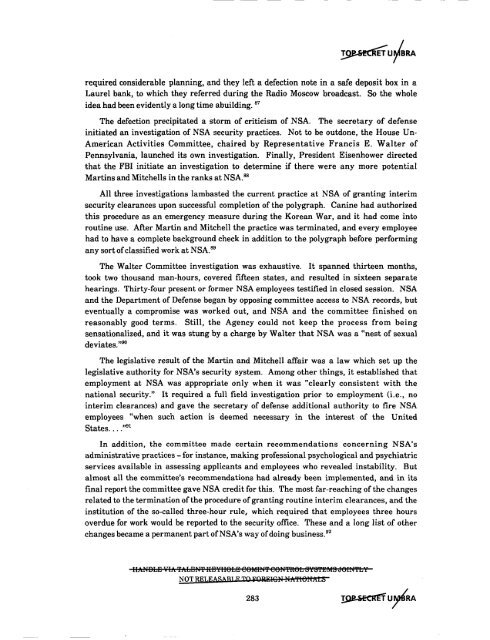American Cryptology during the Cold War - The Black Vault
American Cryptology during the Cold War - The Black Vault
American Cryptology during the Cold War - The Black Vault
Create successful ePaper yourself
Turn your PDF publications into a flip-book with our unique Google optimized e-Paper software.
equired considerable planning, and <strong>the</strong>y left a defection note in a safe deposit box in a<br />
Laurel bank, to which <strong>the</strong>y referred <strong>during</strong> <strong>the</strong> Radio Moscow broadcast. So <strong>the</strong> whole<br />
idea had been evidently a long time abuilding. 87<br />
<strong>The</strong> defection precipitated a storm of criticism of NSA. <strong>The</strong> secretary of defense<br />
initiated an investigation of NSA security practices. Not to be outdone, <strong>the</strong> House Un<br />
<strong>American</strong> Activities Committee, chaired by Representative Francis E. Walter of<br />
Pennsylvania, launched its own investigation. Finally, President Eisenhower directed<br />
that <strong>the</strong> FBI initiate an investigation to determine if <strong>the</strong>re were any more potential<br />
Martins and Mitchells in <strong>the</strong> ranks at NSA.88<br />
All three investigations lambasted <strong>the</strong> current practice at NSA of granting interim<br />
security clearances upon successful completion of <strong>the</strong> polygraph. Canine had authorized<br />
this procedure as an emergency measure <strong>during</strong> <strong>the</strong> Korean <strong>War</strong>, and it had come into<br />
routine use. After Martin and Mitchell <strong>the</strong> practice was terminated, and every employee<br />
had to have a complete background check in addition to <strong>the</strong> polygraph before performing<br />
any sort ofclassified work at NSA. 89<br />
<strong>The</strong> Walter Committee investigation was exhaustive. It spanned thirteen months,<br />
took two thousand man-hours, covered flfteen states, and resulted in sixteen separate<br />
hearings. Thirty-four present or former NSA employees testified in closed session. NSA<br />
and <strong>the</strong> Department of Defense began by opposing committee access to NSA records, but<br />
eventually a compromise was worked out, and NSA and <strong>the</strong> committee finished on<br />
reasonably good terms. Still, <strong>the</strong> Agency could not keep <strong>the</strong> process from being<br />
sensationalized, and it was stung by a charge by Walter that NSA was a "nest of sexual<br />
deviates."9o<br />
<strong>The</strong> legislative result of <strong>the</strong> Martin and Mitchell affair was a law which set up <strong>the</strong><br />
legislative authority for NSA's security system. Among o<strong>the</strong>r things, it established that<br />
employment at NSA was appropriate only when it was "clearly consistent with <strong>the</strong><br />
national security." It required a fun field investigation prior to employment (Le., no<br />
interim clearances) and gave <strong>the</strong> secretary of defense additional authority to fire NSA<br />
employees "when such action is deemed necessary in <strong>the</strong> interest of <strong>the</strong> United<br />
States... .'>91<br />
In addition, <strong>the</strong> committee made certain recommendations concerning NSA's<br />
administrative practices - for instance, making professional psychological and psychiatric<br />
services available in assessing applicants and employees who revealed instability. But<br />
almost an <strong>the</strong> committee's recommendations had already been implemented, and in its<br />
final report <strong>the</strong> committee gave NSA credit for this. <strong>The</strong> most far-reaching of<strong>the</strong> changes<br />
related to <strong>the</strong> termination of<strong>the</strong> procedure ofgranting routine interim clearances, and <strong>the</strong><br />
institution of <strong>the</strong> so-called three-hour rule, which required that employees three hours<br />
overdue for work would be reported to <strong>the</strong> security office. <strong>The</strong>se and a long list of o<strong>the</strong>r<br />
changes became a permanent part ofNSA's way ofdoing business. 92<br />
IIAUBLEl IfI," T1tbEltiT IEElYIISLEl CSMINT CSNTHSL ST{S'fEMS dSUffLY<br />
NOT RELEASABI E TO i:QggISN tfATI61(1iL5<br />
283
















